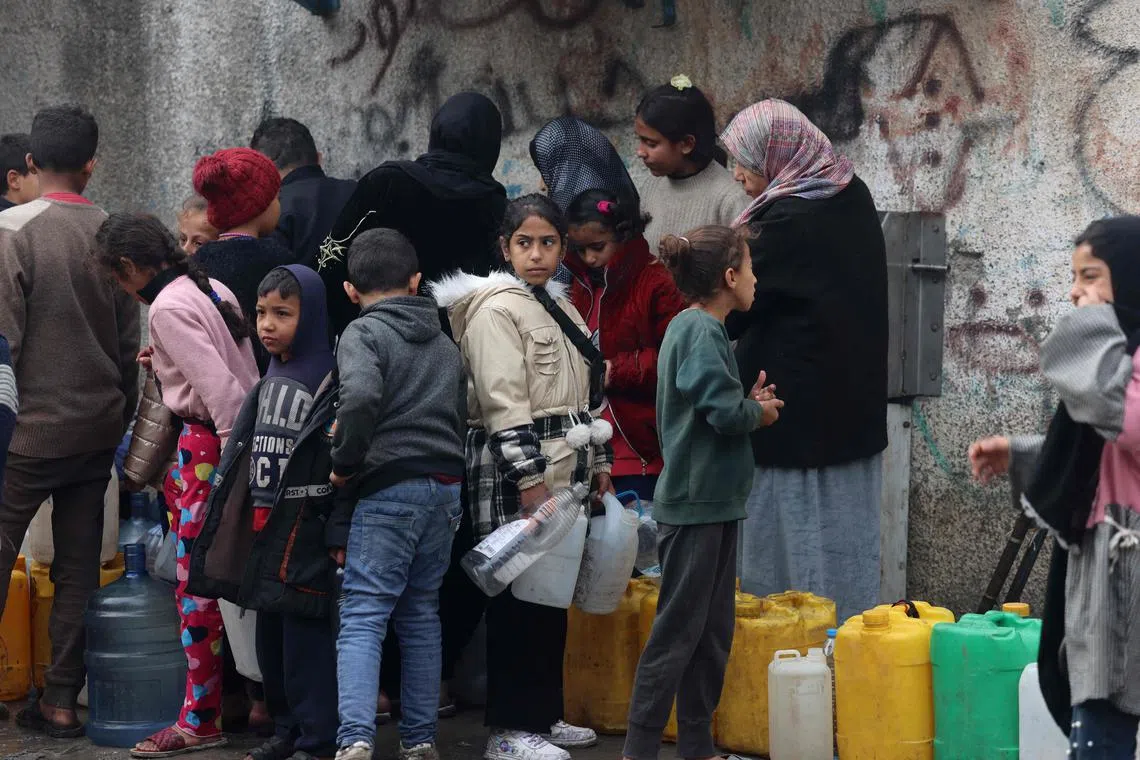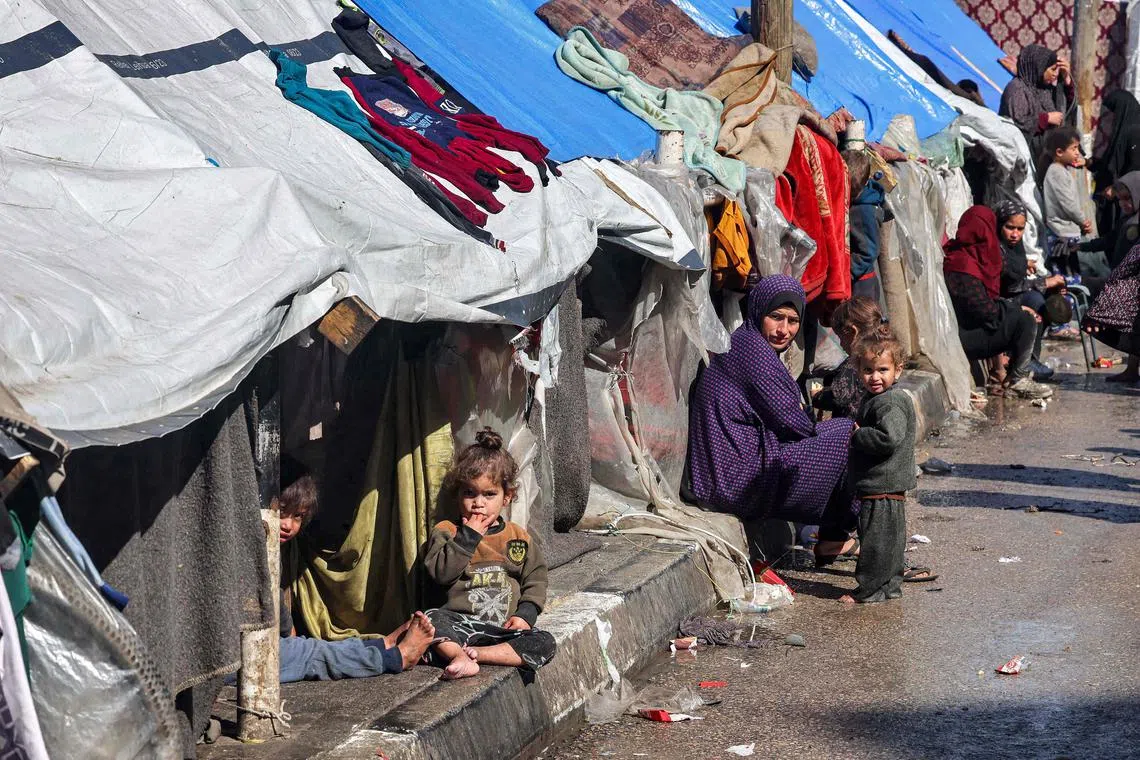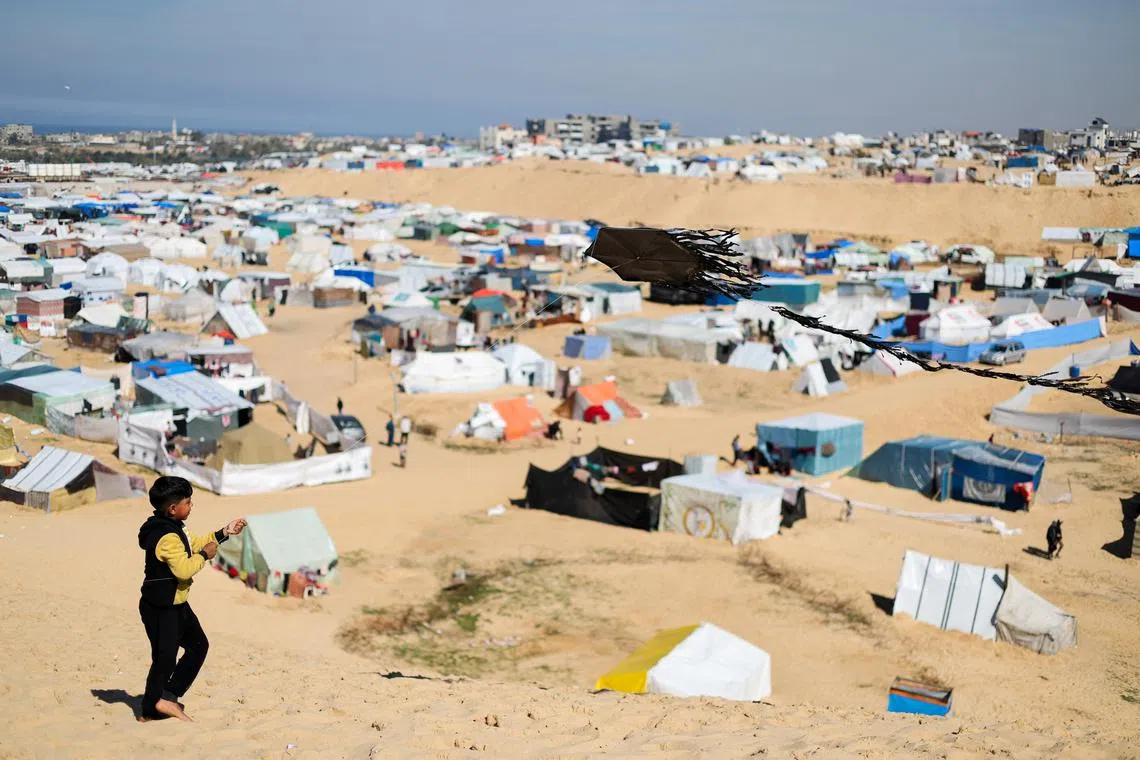Palestinians brace themselves for Rafah evacuation, Israeli assault plan
Sign up now: Get ST's newsletters delivered to your inbox

Women and children queue for water in Rafah, in the southern Gaza Strip.
PHOTO: AFP
Follow topic:
DOHA/JERUSALEM - Trapped in and around Rafah, more than one million Palestinians braced themselves for Israel to complete a plan to evacuate them and launch a ground assault against Hamas fighters in the southern Gaza city.
Aid agencies warned that large numbers of civilians could die in the Israeli offensive
The United Nations Palestinian refugee agency said it did not know how long it could work “in such a high-risk operation”.
“There is a sense of growing anxiety, growing panic in Rafah,” said Mr Philippe Lazzarini, the head of the UNRWA agency. “People have no idea where to go.”
Prime Minister Benjamin Netanyahu’s office on Feb 9 announced the military was ordered to develop a plan “for evacuating the population and destroying”
Israel cannot achieve its goal of eliminating the militants who rule Gaza while those units remain, it said.
The statement, issued two days after Mr Netanyahu rejected a Hamas ceasefire proposal
Washington, Israel’s main supporter, said it would not back an assault that did not protect civilians, and had briefed Israel on a new US national security memorandum
“There are no new standards in this memo. We are not imposing new standards for military aid,” White House press secretary Karine Jean-Pierre told reporters. “They (the Israelis) reiterated their willingness to provide these types of assurances.”
More than a million people driven southwards by more than four months of Israeli bombing of Gaza are packed into Rafah and surrounding areas on the coastal enclave’s border with Egypt.
Cairo has reinforced the frontier, fearing an exodus.
Doctors and aid workers are struggling to supply even basic aid to Palestinians sheltering around Rafah. Many are trapped against a border fence with Egypt and living in makeshift tents.
Israeli forces have been moving southwards towards the city after first storming northern Gaza in response to Hamas’s attack on southern Israel on Oct 7
The United Nations said Palestinian civilians in Rafah needed to be protected, but there should not be any forced mass displacement, which it said went against international law.
“No war can be allowed in a gigantic refugee camp,” said Mr Jan Egeland, secretary-general of the Norwegian Refugee Council, warning of a “bloodbath” if Israeli troops move into Rafah.
The Palestinian Presidency said Mr Netanyahu’s plans aimed to displace the Palestinian people from their land.
“Taking this step threatens security and peace in the region and the world. It crosses all red lines,” said the office of Mr Mahmoud Abbas, head of the Palestinian Authority that exerts partial self-rule in the Israeli occupied West Bank.
An Israeli official who declined to be named said that Israel would try to organise for people in Rafah, most of whom fled there from the north, to be moved back northwards within Gaza ahead of any military operation there.

A woman and children sit outside tents sheltering displaced Palestinians in Rafah, in the southern Gaza Strip.
PHOTO: AFP
Gaza’s Health Ministry said at least 27,900 Palestinians had been confirmed killed in the war. More could be buried under rubble.
Hamas gunmen killed some 1,200 people and took 253 hostages in the Oct 7 attack, according to Israeli tallies.
Almost one in 10 of Gazans under five are now acutely malnourished, according to initial UN data from arm measurements that show physical wasting.
The charity ActionAid said some Gazans were eating grass.
“Every single person in Gaza is now hungry, and people have just 1.5 to 2 litres of unsafe water per day to meet all their needs,” it said.

More than a million people driven southwards by four months of Israeli bombing of Gaza are packed into Rafah and its surrounding areas.
PHOTO: REUTERS
‘All were martyred’
Hours after Mr Netanyahu’s statement, at least 11 Palestinians died in an Israeli air strike on a house in Rafah, according to Hamas media outlets.
Reuters could not independently verify these accounts.
Earlier Israeli airstrikes killed at least 15 people, eight of them in the Rafah area, said Palestinian health officials.
“We were sleeping inside and, when the strike hit, were thrown outside,” said Mohammed al-Nahal, an elderly Palestinian standing beside the rubble of her stricken building.
“It destroyed the entire home. My daughter was killed. My daughter, her husband, her son, all were martyred.”

People walk past tents housing displaced Palestinians pitched along a crowded main street in Rafah.
PHOTO: AFP
Israel’s military said its forces had been in action in the area of Khan Younis and in northern and central Gaza to eliminate militant cells and destroy militant infrastructure.
It says it takes steps to avoid civilian casualties and accuses Hamas militants of hiding among civilians, including at schools, shelters and hospitals. Hamas has denied doing so.
US President Joe Biden said on Feb 8 he had been pushing for a deal to pause fighting to allow the release of hostages, increase the amount of humanitarian aid reaching Palestinian civilians, and normalise relations between Israel and Saudi Arabia.
Hamas this week proposed a ceasefire
Mr Netanyahu rejected as “delusional” Hamas’ terms, a response to a plan developed by the US and Israeli spy chiefs with Qatar and Egypt. REUTERS

